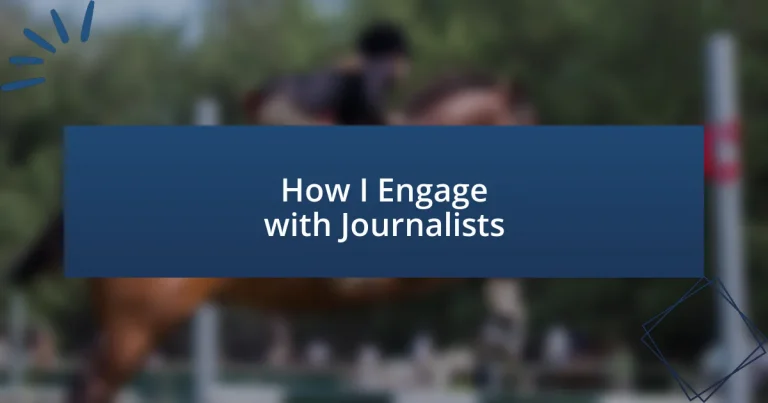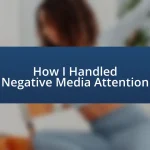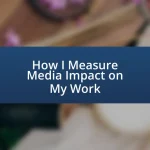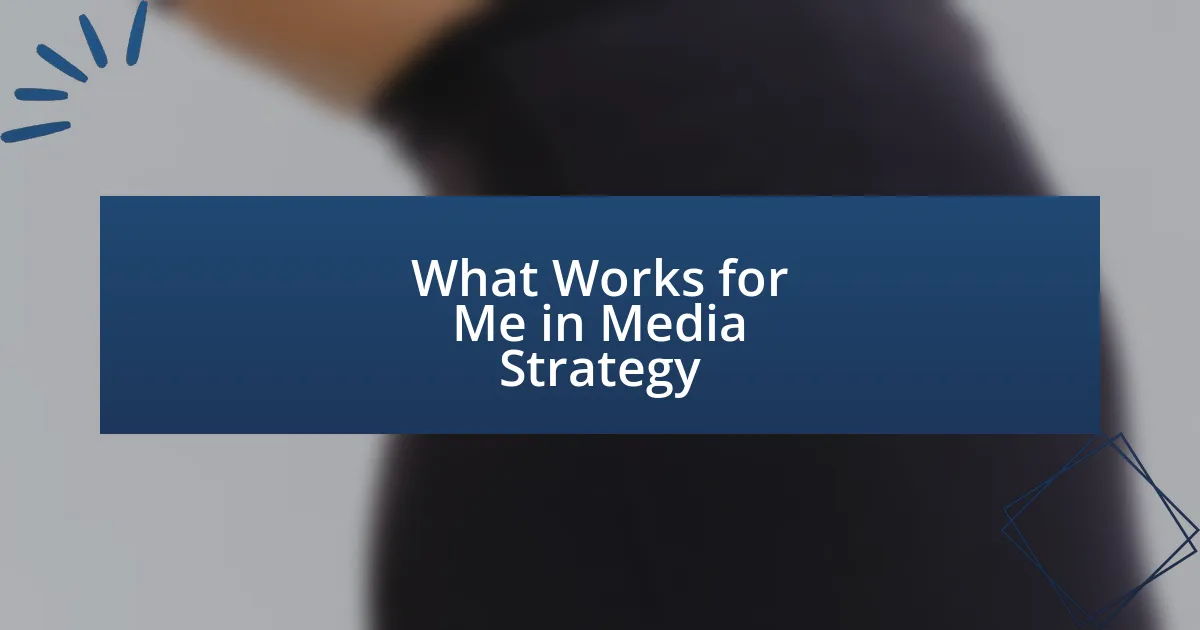Key takeaways:
- Understanding journalists involves recognizing their pressures, empathy, and the impact of their storytelling choices.
- Building relationships with journalists hinges on trust, effective communication, and being available and honest.
- Social media outreach can enhance engagement by personalizing interactions and showcasing compelling narratives.
- Follow-up is crucial; timely appreciation and relevant content can strengthen connections with journalists.

Understanding journalist perspectives
Understanding a journalist’s perspective means recognizing the constant pressure they face to deliver timely, accurate stories. I remember discussing the tight deadlines with a reporter friend over coffee; she shared how each day felt like a race against the clock. It made me appreciate the relentless pursuit of information that drives them.
It’s fascinating to realize how journalists must juggle various angles of a story while being mindful of their audience’s interests. Have you ever considered how a single piece can be interpreted in multiple ways? I often find that the choices they make in framing a story reveal not just facts but also their values and priorities, which adds depth to their writing.
Empathy is a key component in understanding journalists. I recall a time when I witnessed a journalist navigating a sensitive situation at a community event, striving to balance truth with compassion. That moment taught me how important it is to recognize their role as not just storytellers, but as individuals with a deep commitment to their craft and the people involved in their narratives.
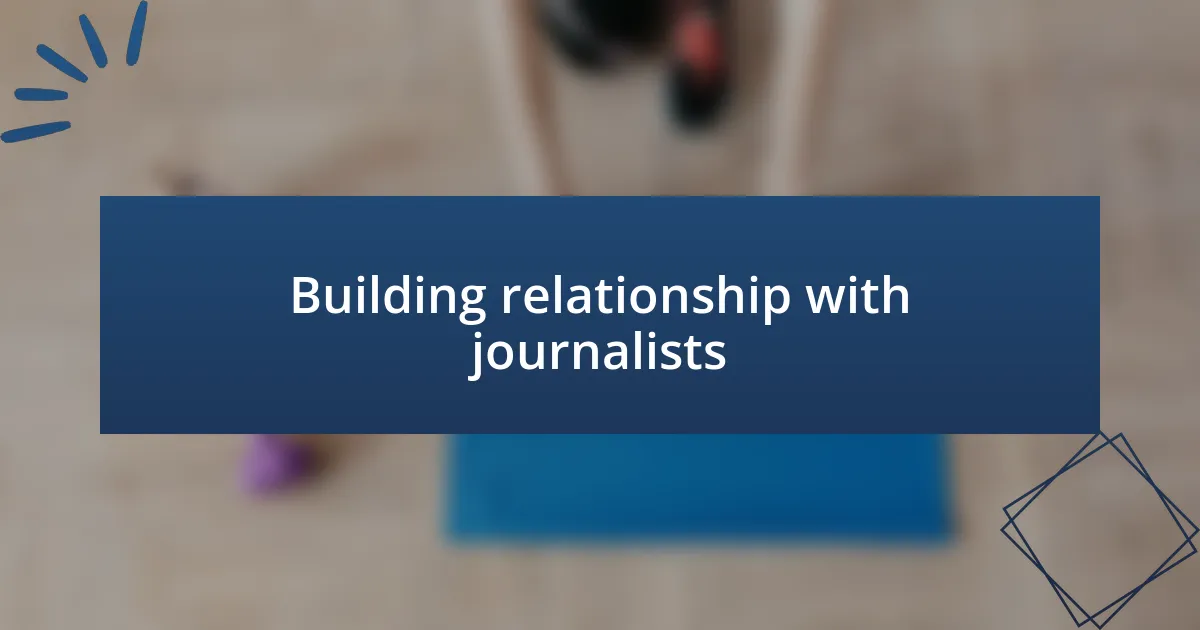
Building relationship with journalists
Building relationships with journalists is about nurturing trust and open communication. I still remember attending a small press conference where I took the initiative to introduce myself to a few journalists. What struck me was how a simple, genuine conversation broke down barriers and fostered a sense of camaraderie. From that day, I learned that being approachable and sincere can make all the difference in building a professional rapport.
To strengthen these connections, consider these strategies:
– Be Available: Respond promptly to inquiries; it shows you value their time.
– Share Insights: Provide useful information or resources that align with their stories; this positions you as a trusted contact.
– Follow Up: Send a quick note or message thanking them for their work; this keeps the line of communication open.
– Attend Events: Join industry functions or social gatherings where journalists are present; personal interactions create lasting bonds.
– Be Honest: Transparency is essential; if you provide misleading information, it can jeopardize future interactions.
Each of these actions contributes to a more meaningful and mutually beneficial relationship with the media, allowing for more fruitful collaborations down the line.
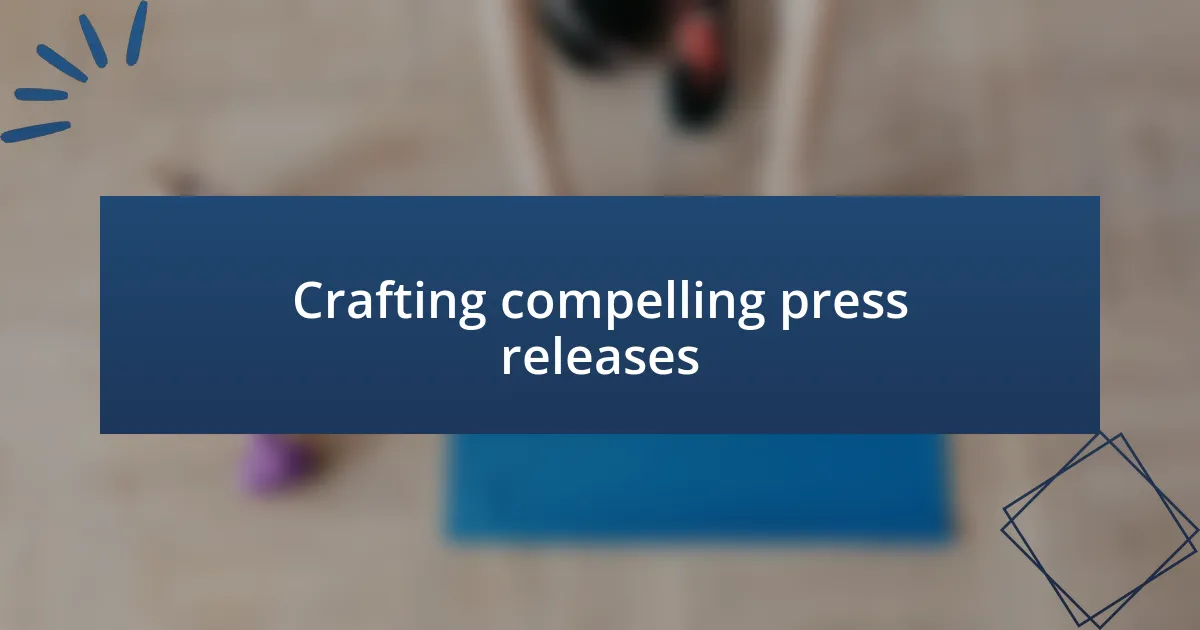
Crafting compelling press releases
Crafting compelling press releases requires a blend of creativity and clarity. I once spent hours refining a press release until it perfectly told the story of an upcoming event. I learned that boiling down complex concepts into engaging narratives is key. Each sentence should engage the reader, drawing them in with captivating headlines and clear messages.
Moreover, understanding the journalist’s perspective is crucial. During a recent experience, I tailored a press release to directly address the interests of a journalist I knew was covering my industry. The result? An excited response and additional coverage I hadn’t anticipated. It taught me that when you speak their language and meet their needs, it not only creates a connection but also enhances the likelihood of your message being published.
Lastly, always consider the timing and format of your press release. I’ve realized that sending it at the right moment can significantly improve visibility. For instance, releasing news on a Wednesday morning, when journalists are often seeking fresh content, can lead to greater chances of coverage. Finding that sweet spot combines strategy with execution, perfectly aligning my objectives with the media’s needs.
| Element | Importance |
|---|---|
| Clarity | Ensures the message is easily understood. |
| Relevance | Tailors the content to the journalist’s audience. |

Using social media for outreach
Using social media for outreach can be a game-changer when trying to engage with journalists. I remember one instance where I crafted a concise yet eye-catching tweet about a notable initiative my organization was launching. I tagged relevant journalists and industry influencers, and the response was immediate. They not only liked and shared the post but also reached out for more information, demonstrating how social media can bridge the gap between organizations and media professionals.
It’s fascinating to think about how social media platforms can amplify a message. On one occasion, I shared behind-the-scenes content from a project we were excited about. I used Instagram Stories to showcase our journey in a personal, engaging way. This visual storytelling caught the eye of a journalist who later featured our work in a prominent article. It made me realize that sometimes, it’s not just about the announcement; it’s about sharing the experience that resonates on a human level.
Engaging with journalists on social media also requires a genuine approach. I often scroll through their profiles to understand their interests and recent stories. By commenting on their posts or sharing relevant articles, I create a connection that makes my outreach feel more organic. I’ve found that showing sincere interest in their work can lead to fruitful conversations—after all, how often do we appreciate when someone takes the time to acknowledge our efforts?
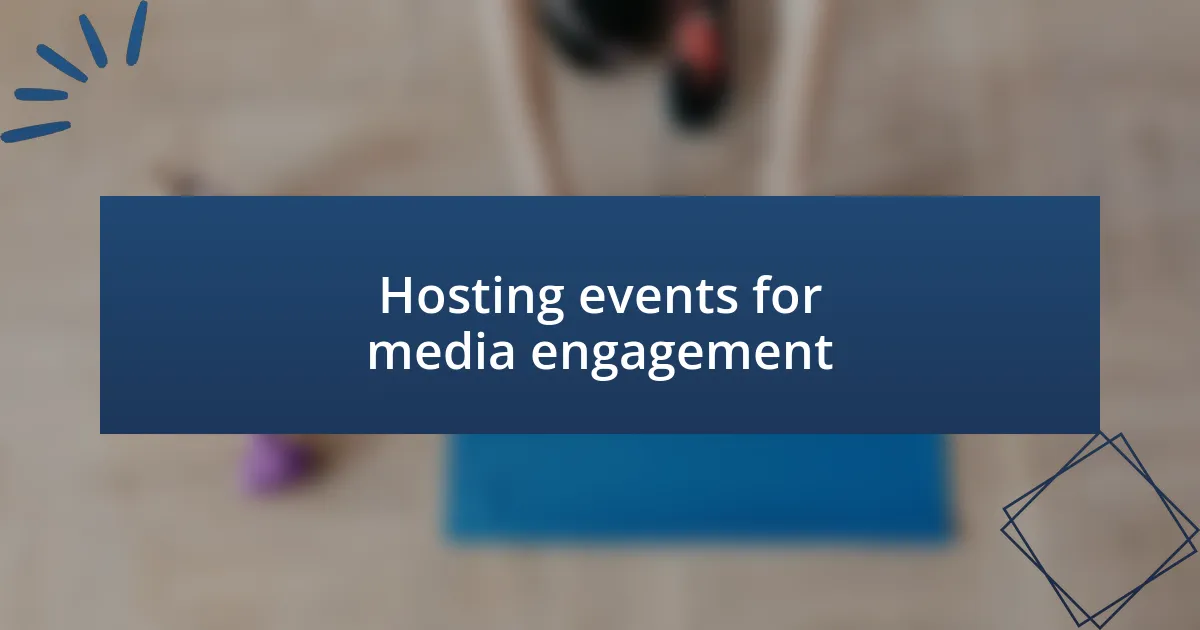
Hosting events for media engagement
Creating engaging events for media outreach has its own unique charm. I vividly remember hosting a press breakfast a few years back. The goal was to share insights about our upcoming campaign in a more intimate setting. Watching journalists lean in, sip their coffee, and actively participate in discussions made me realize how effective face-to-face interactions can be in building relationships.
One thing I’ve learned is that the setting can greatly impact the success of these events. For instance, when I organized a community forum instead of a traditional press conference, it opened up a dialogue between journalists, local leaders, and even residents. The energy was palpable, with everyone contributing ideas and stories. I couldn’t help but think, isn’t that what we want? A platform where true conversations can happen, not just scripted presentations?
I also find that adding a personal touch to these gatherings makes a noticeable difference. For example, at a recent event, I included a short storytelling segment sharing my own experiences related to our mission. It was wonderful to see how this vulnerability sparked genuine discussions among attendees. It made me question—why do we often hold back when these authentic connections can foster better collaborations?
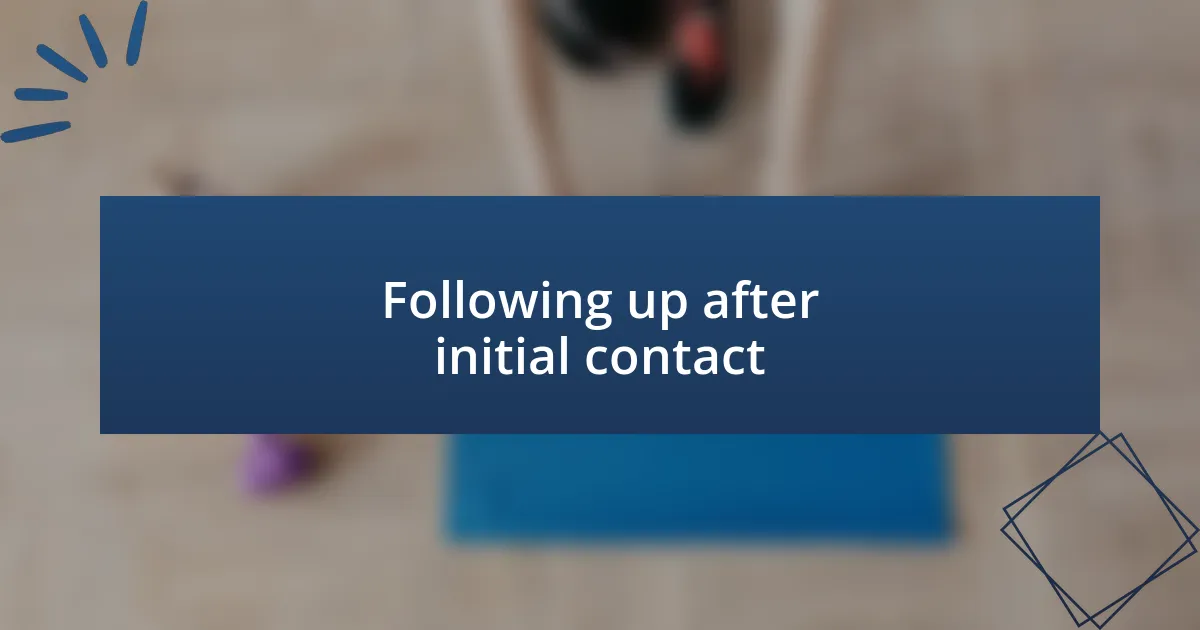
Following up after initial contact
After the initial contact, I always make it a point to send a friendly follow-up email. It’s an opportunity to express my appreciation for their time and reinforce the connection we’ve established. I remember once reaching out to a journalist after a brief chat at an event; not only did I thank them, but I also mentioned a specific topic they were passionate about. The response was immediate and highlighted the importance of showing genuine interest.
Timing is crucial in the follow-up process. I prioritize reaching out within a week of our conversation to keep the momentum alive. I once delayed a follow-up by a few weeks, thinking I was giving them space, only to discover that they had moved on to other stories. That experience taught me that the window for engagement can be fleeting, and promptness can sometimes mean the difference between closing a deal or losing an opportunity.
Sometimes, I’ll include a piece of content or an article that adds value to our discussion in my follow-up. For example, after speaking with a tech journalist, I shared a recent case study relevant to their interests. I found that this not only sparked a further conversation but also positioned me as a reliable resource for them. Isn’t it fascinating how a small gesture like this can pave the way for more meaningful exchanges?
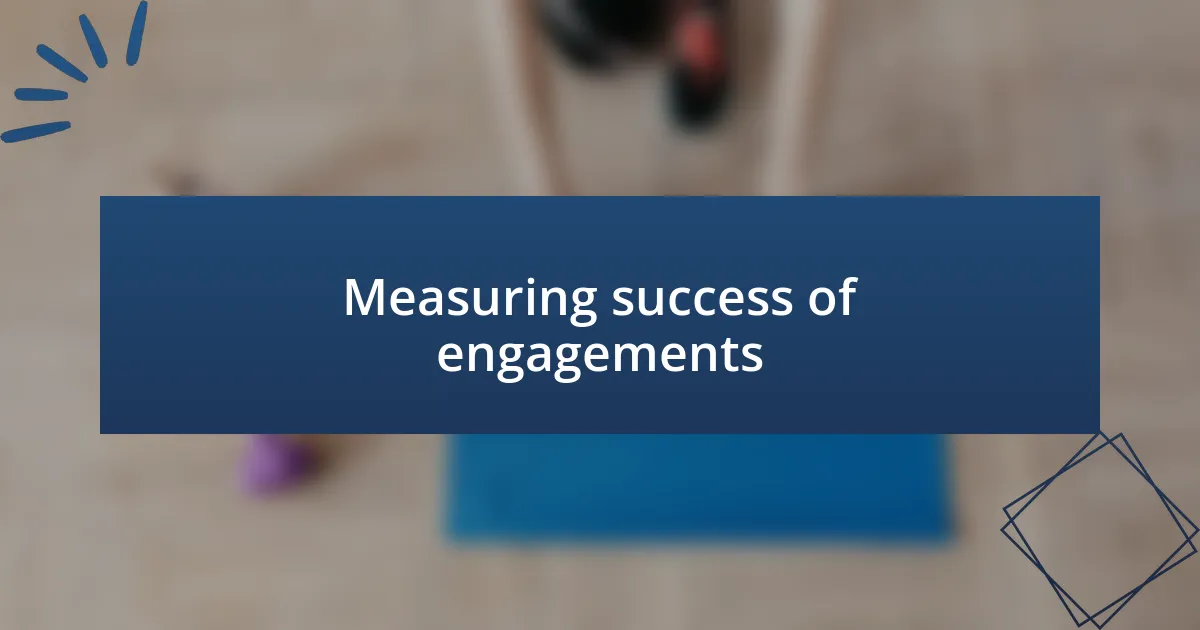
Measuring success of engagements
Success in my engagements with journalists isn’t just about making the initial connection; it’s about evaluating the impact of our interactions over time. I often track responses to my follow-up emails and note if they lead to further discussions or features in their articles. One time, after pitching a story idea, I observed how quickly I received feedback. That immediate response felt validating and gave me a clear indicator that my approach resonated with them.
Another factor I consider is the coverage or mentions I receive in various media outlets. A few months ago, I was thrilled to see a piece I pitched appear in a leading publication. This recognition not only showcased the effectiveness of my engagement but also reinforced the importance of persistence. Have you ever felt that rush when your ideas are recognized publicly? It’s that rush that keeps me motivated to build ongoing relationships.
I also assess the depth of our conversations by reflecting on how often we connect afterward. Are we exchanging ideas regularly? For instance, I’ve had journalists reach out for additional insights weeks after our last conversation, signaling that my contributions were valuable. This ongoing connection is a strong indicator of successful engagement and underlines the importance of nurturing these relationships over time.
